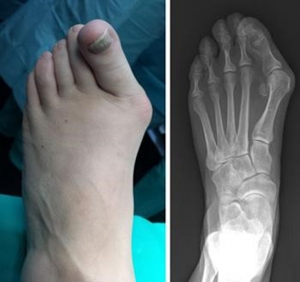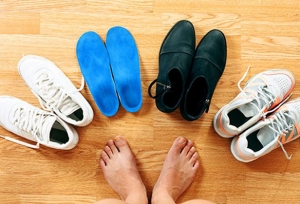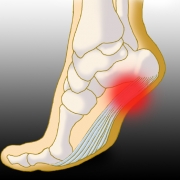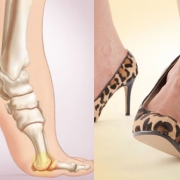Bunions
Your foot and ankle is made up of 26 bones, 33 joints, and more than 100 muscles, tendons and ligaments.
You will walk the equivalent of four times around the world in your lifetime. Nearly 3/4 of the population, which may include you, will get some sort of foot problem along the way.
The common bunion – what is it?
Just think of a bunion or Hallux Valgus as Clinicians will refer to it, as being a lump on the side of the foot near the big toe. The anatomy of the foot is actually changed by bunions and they go deeper than just a lump on the side.
Your bunion develops when the big toe begins to point inwards towards the second toe. Years of abnormal motion and pressure on the joint at the base of the big toe force it to bend inwards causing an often-painful lump on the joint.
The joint at the base of the big toe carries much of your weight when walking, that is why bunions can cause severe and constant pain. The joint may become so stiff and sore that shoes may be too painful to wear.
What are the symptoms of bunions?
You don’t always have any symptoms in the early stages, they become noticeable when the bunion gets worse and when you wear particular types of footwear, maybe shoes that crowd the toes or a loose, flat slipper type and high-heeled shoes.
Symptoms could be:
- Physical discomfort or pain in your big toe or ball of foot
- Redness and swelling over the bump
- Possible numbness along the big toe
- A burning feeling in your big toe
- Difficulty walking
What are the causes? Are stilettos to blame?
Not on their own but … a big contributor to the causes of bunions are shoes that are too narrow or poorly fitted. Try to choose low-heeled, comfortable shoes that provide plenty of space for your toes on the widest part of your foot.
Bunions often are hereditary, they can run in the family …but they can also be the result of the way we walk.
Rheumatoid arthritis can make your joints swell and hurt, which can lead to bunions. Some people are just more likely to get them because of the way their feet are shaped.
Women develop bunions far more often than men, especially as they get older.
People with flexible joints seem to tolerate their bunions more, but others with arthritis or stiffer joints usually have more trouble with their bunions at an earlier stage.
Bunions occur most often in girls between ages 10 and 15, but boys can get them too. Doctors aren’t sure exactly why girls are more likely to have them, but probably something to do with changes in footwear around that age.
How are bunions diagnosed?
Bunions are diagnosed using physical examination and X-rays.
How are bunions treated?
Option 1. Nonsurgical treatments
All bunions are permanent unless surgically corrected, but there are some measures you can take to be more comfortable or to slow a bunions progression. Bunion treatment always begins with nonsurgical treatments.
The treatments are simple and for many people, the easiest option is changing over to wider, properly fitting shoes, low heel, cushion soles, not loose but providing stable firm support.
Here are 6 other approaches which may relieve the pain and pressure on the toe joint:
- Maintain a normal weight.
- Protect the bunion with gel-filled pad at night time
- Use shoe inserts to help position the foot correctly. Arch supports or prescription orthotic devices.
- Wear a splint at night to hold the toe straight and ease discomfort.
- Take non-steroidal anti-inflammatory drugs such as ibuprofen.
- Use warm soaks, ice packs, foot spa whirlpool, where possible ultrasound and massage.
Some patients begin treating their bunions by stretching the feet to realign the toes, or using devices such as toe spacers or bunion splints, but this is never a permanent solution
Most adolescent bunions are treated non-surgically at least until the patient grows to full adulthood.
Option 2. When it’s time for surgery
It is important to visit your family doctor as soon as possible if you have continual or fierce pain. You may be referred to a podiatrist. Podiatrists diagnose and treat conditions of the foot & ankle. You could also be referred to an Orthopaedic consultant who may specialise in foot & ankle surgery.
It’s time to consider surgery when you’ve felt pain for at least a year.
Your doctor may also recommend surgery because bunions can lead onto other painful foot problems, such as hammertoes, bursitis (a bunion below the little toe) or pain in the balls of your feet.
If bunions develop, they can lead to permanent joint damage and may require MTP joint fusion. This is a surgical procedure which fuses the big toe permanently.
Older patients often have bunions causing other problems. The pain is more constant, or is creating problems with the second toe.
Surgical treatments
Surgery is only considered if nonsurgical treatments fail to provide satisfactory relief.
The goal of surgery is to re-align the big toe to its correct position. The surgeon will position and re-align bones, ligaments, tendons and nerves back into their original composition and remove the bunion bump, straightening out the big toe and restore more normal function to the foot.
There are many types of surgery for bunions, but about a half-dozen are routinely used.
Usually, metal pins, screws and sometimes small metal plates are implanted to hold the bones in the right position. Surgery can be very effective at correcting bunions, and the outcomes for patients are generally good.
There are new implants available to fix bunions. The MAGNEZIX implants are bio-absorbable and over time will change into bone. This means that there is no need of any further surgery in later years to remove the implants.
For more information please follow these links.
Magnezix bio-absorbable implants











